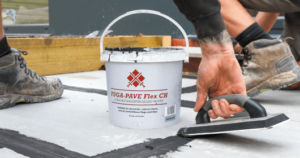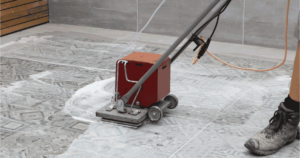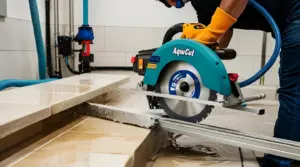Stuart Middleton, Executive Chairman, Aquacut Limited/Tilers Tools
Anecdotal evidence suggests that more porcelain is used in garden makeovers than traditional stone or cementitious products. With the increasing popularity of porcelain tiles in landscaped areas, professional landscapers and tilers have had to learn to use the best installation methods to avoid expensive problems arising. Selecting the best grout is very important to create a long-lasting and attractive finish.
There are four key types of grout in use today. The first two from the following list dominate the market:
1. Brush in grout
2. Hybrid cementitious grout
3. Ordinary tilers’ cementitious grout
4. Sand + cement mortar
The above list is believed to be the order of market share, so while brush-in grout is the most popular, it may not be the most appropriate.
In this article, we explore the dangers of using the wrong grout and the benefits of selecting the best.
We have previously written about the benefits of a fibre reinforced mortar cement and primer combination. For example, our FUGA-PAVE Parts A and B, launched in 2020, are gaining a loyal following and are being used instead of traditional sand + cement mortars owning to their superior strength, permeability, and other properties. Grouts suitable for porcelain installations are also growing market share, so let us look at the reasons why.
PROBLEMS, PROBLEMS
Flags de-bonding from the mortar base
Porcelain flags are largely impervious to water, so if rainwater flows over the flags and through permeable grout joints, it can end up behind the tiles and may become trapped. This is especially dangerous if a traditional non-pervious mortar using traditional sand + cement is used to fix the flags. This trapped water can then cause the flags to de-bond (‘pop’) during periods of freeze thaw or strong heat from the sun.
Water in joints freezing and cracking up
Like the above danger, if water gets into a joint during a freeze thaw cycle, it is highly likely to lead to the swift break-up of the grout, leading to expensive and time-consuming removal and reinstallation.
Weeds, algae, and black spot destroying grout joints
Permeable grouts, especially if used in porcelain installations, may also suffer from the ingress of dirt. Imagine the amount of dust and detritus that falls on flags. When it rains, this dirt can be washed into the permeable grout joint, creating a bed for weeds, algae, and black spot. Under these conditions it is most likely the grout will swiftly deteriorate and need to be replaced within a very short period.
Efflorescence
Efflorescence is the white chalky appearance that can result from the migration of light-coloured salts through the grout – especially dangerous if a traditional cementitious grout is used.
Colour deterioration
Colour deterioration is usually caused by the strong UV rays from the sun. A number of grouts in use today may not be UV colour fast which would lead to the grout being ‘bleached’ of colour and could end up with a patchy, unattractive finish.
Picture framing and grout bloom on flags
Several grouts in use are formulated with resins that may be very difficult to clean off the surface of flags, whether porcelain, stone or cementitious slabs are installed. The resin may stain the tiles in such a way to create an unattractive bloom over the flags, or a picture frame effect around the edges of the slabs.
Difficulty to apply and wash off
A few grouts are difficult to apply and wash off. This leads to increasing numbers of call-backs from clients dissatisfied with the finish of their installations, especially for porcelain installations where homeowners are looking for that perfect finish.
Eco-friendly?
Increasingly important to discerning clients. Is your grout eco-friendly?
So, let us look at the four types of grout and consider their strengths and weaknesses.
1. Brush-in grout
Strengths
· Well-known and widely used by landscapers.
· Quick, simple installation.
· Use on permeable materials, such as cementitious products and certain types of stone that lets water through.
Weaknesses
· Brush-in grout is permeable, meaning that water can pass through the grout and may accumulate at the back of the flag.
· Grout may trap water and deteriorate during freeze/thaw cycles.
· Some grouts may have colouring additives that are can be bleached by strong sunlight.
· Resins used as a binder may create issues such as blooms on tiles or picture framing, spoiling the appearance of the installed flags.
· Limited colours.
2. Hybrid cementitious grout (such as our FUGA-PAVE Flex CH)
Strengths
· Passes the drop water test to prevent water ingress.
· Efflorescence free formula.
· UV stable/sun damage resistant.
· Easy application.
· Easy to clean.
· Eco Friendly.
· Range of colours.
· Long-lasting.
· Suitable for use on porcelain, stone, and cementitious products.
Weaknesses
· Porous stone and cementitious products ought to be sealed prior to grouting.
3. Ordinary tilers’ cementitious grout
Strengths
· Easy application.
· Easy to clean.
· May be eco-friendly.
· Range of colours.
Weaknesses
· May be susceptible to efflorescence.
· Some are designed for internal use and may not be UV/colour stable.
· May be subject to cracking with effects of heat/cold expansion/shrinkage.
4. Sand + cement mortar
Strengths
· Landscapers have used this on natural stone and cementitious products.
· Easily applied.
· Easy clean off.
Weaknesses
· May be permeable allowing water ingress.
· No range of colours.
· Proven to break up quickly.
· Unattractive finish.
SUMMARY
For porcelain installations, there is only one real choice – use a hybrid cement grout such as Tilers Tools FUGA-PAVE Flex CH for the best, longer lasting finish. May also be used on stone and cementitious flags. Brush-in grout should be avoided for porcelain installations but may be used for permeable stone such as sandstone, or cementitious flags.




